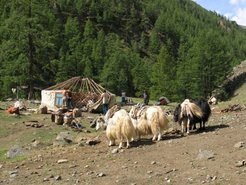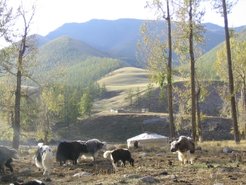Plural World Interpretations: The Case of the Tyvans in South Siberia
Publication
Plurale Weltinterpretationen. Das Beispiel der Tyva Südsibiriens. [Plural World Interpretations. The case of the Tyvans in South Siberia] Fürstenberg/Havel: SEC Publications/Kulturstiftung Sibirien gGmbH. (peer-reviewed, 340 pp., summaries in Russian and English (each with 11pp.), three maps, 104 photographs, 13 drawings, in print)
Abstract
Plural World Interpretations are part of our everyday life even if we are not aware of the fact. They result from the simultaneous existence of different but equal models for interpreting the world we live in. These models are products of human constructivity and co-exist as parallel realities, complementing and contradicting each other. Based on fieldwork among the Tyva of southern Siberia, the book discusses the practice of dealing with this multiplicity of world interpretations and shows how individual actors oscillate flexibly between two of many possible models for interpreting specific situations and act on them. The rules Tyvans apply in varying contexts, the reasons behind their choices and the consequences they have to deal with, are analysed. The result is an account of contemporary culture that explores the flexibility and plurality of human interpretation, action and behaviour.
Summary of “Plural World Interpretations: The case of the Tyvans in South Siberia”

Plural World Interpretations stands for the plurality of world interpretation models to be observed in the world today and for the human ability to handle them in a flexible manner. By analyzing the plurality of world interpretations among the South-Siberian Tyvans the present book proposes an alternative to socio-cultural studies that characterize societies as “traditional” or “modern.” Instead of making a strict distinction between traditional and modern elements of culture, the present study demonstrates their co-existence and co-operation. In addition, the term “plural world interpretations” will help to meet the challenge of adopting a widened perspective that shows tradition and modernity as equal, co-existing side by side.
The following definition clarifies how I use this term in the present book: Plural World Interpretations refer to human interpreting as well as human acting and behaving, based on these interpretations, which rest upon the flexible use of simultaneous and equivalent models for interpreting the world. These models of world interpretation (German Deutungsmodelle) are coherent systems having both structure and substance. Supplementing and contradicting each other they are part of the knowledge, behavioural and action repertoire of human beings.

In this case study two of many different models of world interpretation could be identified. Both exist as equally valued realities but can structurally be differentiated as “model of human dominance” and “model of interaction between human and nonhuman subjects.” The first stresses “the human dominance over the environment, regarded as a series of more or less passive objects of human agency,” the second emphasizes the “interactions in a world including and encompassing humans, and consisting of both human and non-human subjects.” Both models refer to coherent systems and are part of the repertoire of knowledge, behaviour and acting of West Tyvan agents. To them, these models count as equal and mutually contradictory. The models compete and oppose each other, but form a continuum within a single person to the effect that the human agent is constantly positioning him- or herself, depending on situations and contexts. The empirical material makes clear that West Tyvans use these models in various ways – replacing, complementing and mixing them according to their individual needs in specific contexts.
Furthermore this case study demonstrates how local actors deal with the plurality of world interpretations, how they switch from one to another and how they mix them in different situations and contexts. The rules of their flexible handling, the reasons behind their choices, and the consequences of their choices are analysed.

